

Glasmodelle der Blaschkas. Glasmodell einer Seeanemone Glasmodelle von Seeanemonen Diese von Haeckel gezeichnete Kieselalgendarstellung diente den Blaschkas als Vorlage für ihre Modelle über diese Spezies.
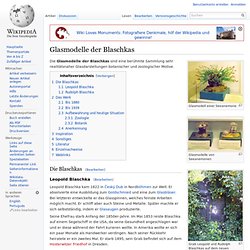
Leopold Blaschka bei der Arbeit Glasmodell eines Kaschubaumzweiges mit Blütendetails im Harvard Museum of Natural History Die Glasmodelle der Blaschkas sind eine berühmte Sammlung sehr realitätsnaher Glasdarstellungen botanischer und zoologischer Motive. Die Blaschkas[Bearbeiten] Leopold Blaschka[Bearbeiten] Leopold Blaschka kam 1822 in Český Dub in Nordböhmen zur Welt.
Seine Ehefrau starb Anfang der 1850er-Jahre. Rudolph Blaschka[Bearbeiten] Rudolph (auch Rudolf) Blaschka wurde im Jahre 1857 geboren. Rudolph Blaschka beschäftigte sich intensiv mit der Flora Mitteldeutschlands sowie der Fauna des Mittelmeeres, der Nord- und Ostsee. Er starb 1939 und hinterließ seine Frau (aber keine Kinder). Das Werk[Bearbeiten] Die Blaschkas wurden berühmt, da sie hunderte von Glasmodellen von Meerestieren und -pflanzen fertigten. Blaschka - Bing Images. Blaschka glass models. An artist in glass Leopold Blaschka joined his family's jewellery and metalwork business as a young man in the mid-1800s in what is now the Czech Republic.

There he learned the art of lampworking - bending and shaping glass with a gas torch. The Blaschka models revealed an often hidden world of underwater life, such as this jellyfish, Aurelia aurita. When Leopold's wife and father died in quick succession, his life shattered. He sailed to America to grieve. Illuminating hidden depths His impressively accurate and beautiful work caught the eye of a museum in Dresden that was struggling to display animals without backbones, like jellyfish. Blaschka-Haus e.V. Blaschka Invertebrate Models. Blaschka Sea Creatures Cornell Warmus. Ocean Realm magazine: The Blaschka Octopus at Cornell University Summer 2001 cover photograph by William Warmus More Than Art:

The Glass Flowers. Before the development of high-speed moving image media, or fiberglass, naturalists and educators faced a quandary: it was often impossible to demonstrate exactly what an invertebrate looked like without a live specimen, because the spine collapses and color leaches out of one preserved in alcohol.
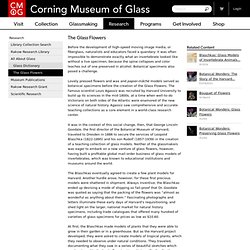
Botanical specimens also posed a challenge. Harvard Gazette: These creatures see dusty duty. The man-of-war's blue sail shone under the display case's bright lights, the glass tentacles of the jellyfishlike animal so delicate that the tread of a visitor to the Museum of Comparative Zoology's Invertebrate Department sets them waving.
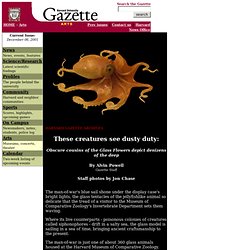
Where its live counterparts - poisonous colonies of creatures called siphonophores - drift in a salty sea, the glass model is sailing in a sea of time, bringing ancient craftsmanship to the present. The man-of-war is just one of about 360 glass animals housed at the Harvard Museum of Comparative Zoology. They were created in the late 1800s by the father and son team of Leopold and Rudolph Blaschka, creators of the Harvard Botanical Museum's famous Glass Flowers. The glass creatures illustrate exotic and alien animals that dot the sea floor and drift on ocean currents, from the more familiar squid and octopuses, to otherworldly nudibranchs, ghostly ctenophores, marine worms, and microscopic protozoa.
Catalog sales "They weren't exactly a dime a dozen. Eclipsed for decades, Harvard's glass animals step out. By Steve Bradt FAS Communications Long overshadowed by their famed floral kin, some of the exquisite 19th century glass animals housed at Harvard's Museum of Comparative Zoology (MCZ) have finally hit the road for a Minnesota exhibit - the first time in Harvard's nearly 130-year ownership that the rare sculptures are known to have left Cambridge.
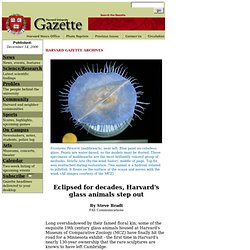
The exhibit of 29 invertebrate models, dubbed "The Glass Sea Treasures of Harvard: The Age of Darwin," continues through next February at the Underwater Adventures Aquarium in Bloomington, Minn. Harvard Gazette: Care for Glass Flowers branches out. Natural History Museum's fragile flowers get needed cleaning and repair By Andrew Brooks Gazette Staff The Glass Flowers - Harvard's majestic collection of more than 4,000 botanical models - is proof that the marriage of art and science is not only possible, but something quite extraordinary.
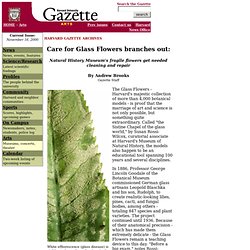
Called "the Sistine Chapel of the glass world," by Susan Rossi-Wilcox, curatorial associate at Harvard's Museum of Natural History, the models also happen to be an educational tool spanning 100 years and several disciplines. In 1886, Professor George Lincoln Goodale of the Botanical Museum commissioned German glass artisans Leopold Blaschka and his son, Rudolph, to create realistic-looking lilies, pines, cacti, and fungal bodies, among others - totaling 847 species and plant varieties.
The project continued until 1936. Since 1998, the museum, led by Joshua Basseches, executive director, has been engaged in an effort to halt future deterioration and repair existing damage, where possible. Natural History Museum Picture Library. Sea creatures of the deep - the Blaschka Glass models. During the late 19th century, Leopola Blaschka (1822-1895) and his son Rudolf (1857-1929) produced beautifully detailed glass models of bizarre sea creatures for natural history museums and aquaria all over the world.
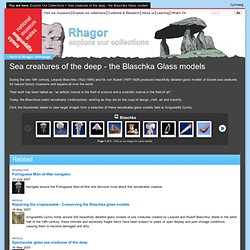
Their work has been hailed as: “an artistic marvel in the field of science and a scientific marvel in the field of art.” Today, the Blaschkas seem remarkably contemporary: working as they did on the cusp of design, craft, art and industry. Click the thumbnails below to view larger images from a selection of these remarkable glass models held at Amgueddfa Cymru. Ucl.ac. Fondazione Scienza e Tecnica - Firenze. Glass Mirrors Life in the Seas - Interactive Feature.